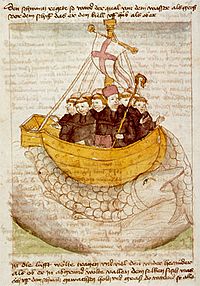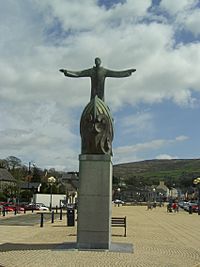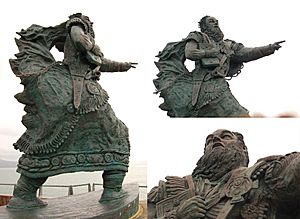Brendan the Navigator facts for kids
Quick facts for kids SaintBrendan the Navigator |
|
|---|---|

"Saint Brendan and the Whale" from a 15th-century manuscript
|
|
| Catholic priest, abbot | |
| Born | c. AD 484 Ciarraighe Luachra near Tralee, Kingdom of Munster |
| Died | c. AD 577 Annaghdown, Kingdom of Connacht |
| Venerated in | Catholic Church Eastern Orthodox Church Anglican Communion |
| Major shrine | Clonfert, Ireland |
| Feast | 16 May |
| Attributes | whale; priest celebrating Mass on board a ship while fish gather to listen; one of a group of monks in a small boat |
| Patronage | boatmen; divers; mariners; sailors; travellers; whales; portaging canoes; Diocese of Clonfert; Diocese of Kerry |
Brendan of Clonfert (born around 484 AD, died around 577 AD) was an early Irish monastic saint. He is known as one of the Twelve Apostles of Ireland. People also call him Brendan the Navigator, Brendan the Voyager, or Brendan the Bold. In Irish, his name is Naomh Bréanainn or Naomh Breandán.
Saint Brendan is most famous for his amazing journey to find the "Isle of the Blessed," sometimes called "Saint Brendan’s Island." The story of his trip is told in an old book called The Navigatio Sancti Brendani Abbatis (which means Voyage of Saint Brendan the Abbot). His special day, or feast day, is celebrated on May 16 by Catholics, Anglicans, and Orthodox Christians.
Contents
The Life of Saint Brendan
Brendan's Early Life
Brendan was born in 484 AD in Tralee, in County Kerry, located in the southwest of Ireland. His parents were named Finnlug and Cara. It is believed he was born near the Kilfenora/Fenit area.
He was baptized by Erc of Slane and was first going to be named "Mobhí." However, special signs at his birth led to him being called 'Broen-finn,' meaning 'fair-drop.' For five years, he was taught by and lived with Saint Íte of Killeedy, who was known as "The Brigid of Munster." When he was six, he went to Jarlath's monastery school in Tuam to continue his education. Brendan is thought to be one of the "Twelve Apostles of Ireland," meaning he was taught by the famous teacher, Finnian of Clonard.
Starting Monasteries
When Brendan was 26, he became a priest, ordained by Erc. After this, he started many monasteries. His first journey took him to the Aran Islands, where he founded a monastery. He also visited Hinba, an island off the Scottish coast, where he is said to have met Columcille. On the same trip, he traveled to Wales and then to Brittany, which is on the northern coast of France.
Between 512 AD and 530 AD, Brendan built monastic cells (small living spaces for monks) at Ardfert and Shanakeel. Shanakeel means "Old Church" and is at the foot of Mount Brandon. From here, he is believed to have started his famous seven-year journey to find Paradise.
The Legendary Sea Journey
Brendan is most famous for his incredible journey to the Isle of the Blessed. This story is told in the Navigatio Sancti Brendani Abbatis, written in the 9th century. Many versions of the story exist. They tell how he sailed into the Atlantic Ocean with sixteen monks. Some stories say there were fourteen monks and three people who joined at the last minute but did not truly believe. One of his companions was said to be Malo.
This voyage is thought to have happened between 512 AD and 530 AD. During his trip, Brendan supposedly saw Saint Brendan's Island, a beautiful island full of plants. He also met a sea monster, an adventure he shared with his friend Columcille. The most famous part of his journey is when he landed on an island that turned out to be a giant sea monster named "Jasconius"!
The Voyage of Saint Brendan the Abbot
The oldest known copy of The Voyage of Saint Brendan the Abbot was written around 900 AD. There are over 100 copies of this story across Europe, and it has been translated many times. The Navigatio is clearly a Christian story, but it also describes natural events and amazing, imaginary places. This made it popular with many different people.
On the coast of Kerry, Brendan built a currach-like boat. This boat was made of wattle (woven branches) and covered with animal hides. These hides were treated with oak bark and softened with butter. He added a mast and a sail. Brendan and a small group of monks fasted for 40 days. After a prayer on the shore, they set off in the name of the Most Holy Trinity.
The story uses a lot of imagination. For example, it talks about Hell where "great demons threw down lumps of fiery slag from an island with rivers of gold fire." It also mentions "great crystal pillars." Many people think these descriptions might be about volcanic activity near Iceland or about icebergs.
A Summary of the Journey
Brendan's journey begins when he meets Saint Barinthus. Saint Barinthus tells him about The Promised Land for Saints (Terra Repromissionis Sanctorum). After hearing about this amazing place, Brendan decides he wants to visit it too. He gathers 14 monks who pray with him and agree to join his voyage. Before they leave, Brendan and the monks fast for 40 nights.
They first sail to an island called Saint Edna. After Brendan and his 14 monks build a small boat, three more people join them. Brendan says these three extra people will not return to Ireland because their number makes the group "unholy."
For seven years, Brendan and his students travel the seas, finding many different places while looking for the Promised Land. One of the first islands they find is empty. Here, the first of the three extra monks dies. After this, Brendan and his men leave and continue to the Island of Sheep.
After a short stay on the Island of Sheep, Brendan and his crew land on what they think is an island. But it turns out to be the back of a giant fish named Jasconius! When they light a fire, the "island" starts to move, showing it's a living creature. Other places they visit include the Island of Birds, the Island of Ailbe (where silent monks live), and the Island of Strong Men. In some stories, the second of the three extra people stays on the Island of Strong Men. The third is taken away by demons.
After traveling for seven years and visiting some places more than once, they finally reach the Promised Land for Saints. They are welcomed and allowed to enter for a short time. Amazed by what they have seen, they return to Ireland filled with joy.
Understanding the Story
The Navigatio is part of a popular type of Irish story called an immram. Irish immrams were popular in the 7th and 8th centuries. An immram is a tale about a hero's adventures at sea. Some of these stories involved searching for and visiting Tír na nÓg, a magical island far to the west. The Navigatio combines this storytelling style with the religious practice of Irish monks traveling alone in boats, much like desert monks lived alone in caves.
Brendan's voyages became one of Europe's most famous and lasting legends. Because many facts about Brendan's journeys come from the Navigatio, it's hard for experts to tell what is real and what is folklore. The story of Brendan's voyage, developed during this time, shares some features with immrams. Like an immram, the Navigatio tells the story of Brendan and his monk companions setting out to find the terra repromissionis sanctorum ("Promised Land of the Saints"), which is like an Earthly Paradise.
Some experts believe that trying to find real places from the Navigatio misses the point. They say the author's goal was to tell a story about "salvation, following religious rules, and the faith needed for such a journey."
Connections to Other Stories
Scholars discuss whether the Navigatio influenced The Voyage of Máel Dúin or if it was the other way around. Some suggest that an early Navigatio influenced an early Mael Duin, and that both stories borrowed ideas from each other as they grew. The Navigatio uses the immram traditions but puts them into a Christian setting.
A key similarity between Mael Duin and the Navigatio is the addition of three extra passengers in both stories. Mael Dúin is joined by his foster brothers, and Brendan by three extra monks. Both additions cause problems for the voyages. Only when these extra people are no longer part of the journey can each voyage be completed.
An Early Dutch Version
One of the oldest written versions of Brendan's legend is the Dutch story De Reis van Sinte Brandaen (The Voyage of Saint Brendan) from the 12th century. Experts think it came from a lost German text mixed with Irish elements. It combines Christian ideas with fairy tale elements.
De Reis van Sinte Brandaen describes "Brandaen," a monk from Galway, and his nine-year voyage around the world. The journey began as a punishment from an angel. The angel saw that Brendan did not believe in a book about the miracles of creation and saw him throw it into a fire. The angel told him that truth had been destroyed. On his journeys, Brandaen sees amazing and scary things. He meets Judas Iscariot (frozen on one side and burning on the other), people with pig heads and wolf teeth, and a huge fish that circles Brandaen's ship by holding its tail in its mouth.
The Mystery of Saint Brendan's Island

While the story is often seen as a religious tale, there has been much talk about whether the legends are based on real events. People have suggested many possible places for Saint Brendan's Island. Old maps from before Christopher Columbus showed it in various locations. These included places from southern Ireland to the Canary Islands, Faroes, or Azores, and even near the equator.
Did Brendan Reach North America?
The idea of Saint Brendan's Island was mostly forgotten until a new theory came up. This theory suggested that the Irish were the first Europeans to reach the Americas.
However, there is no strong proof that Brendan ever reached Greenland or the Americas. The Saint Brendan Society celebrates the idea that Brendan was the first European to reach North America. Tim Severin showed that it is possible for a leather-covered boat, like the one described in the Navigatio, to reach North America. Severin's film The Brendan Voyage from 1978, which showed his team's journey, inspired the Irish composer Shaun Davey to write his music piece "The Brendan Voyage".
The Navigatio was well-known in Europe throughout the Middle Ages. Maps from Christopher Columbus’ time often included an island called Saint Brendan's Isle in the western Atlantic Ocean. Some historians, like Paul Chapman, argue that Christopher Columbus learned from the Navigatio that ocean currents and winds would help him travel west by a southern route from the Canary Islands. He also learned that returning east would be easier by a more northern route. Columbus followed this plan on all his voyages.
Brendan's Later Life
Brendan traveled to Wales and the holy island of Iona, off the west coast of Scotland. When he returned to Ireland, he started a monastery in Annaghdown, where he lived for the rest of his life. He also founded a convent (a place for nuns) at Annaghdown for his sister Briga.
After setting up the bishopric of Ardfert, Brendan went to Thomond. Around 550 AD, he founded a monastery at Inis-da-druim (now Coney Island) in County Clare. He then journeyed to Wales and studied under Gildas at Llancarfan. From there, he went to Iona. It is said he left signs of his religious work at Kil-brandon (near Oban) and Kil-brennan Sound.
After three years of religious work in Britain, he returned to Ireland. He continued to spread Christianity in different parts of Leinster, especially at Dysart, County Kilkenny, and Killeney near Durrow. He built churches at Inchiquin, County Galway, and Inishglora, County Mayo. He founded Clonfert in Galway around 557 AD.
Brendan died around 577 AD in Annaghdown, while visiting his sister Briga. He worried that after his death, people might take parts of his body as relics. So, he had arranged for his body to be secretly taken back to the monastery he founded in Clonfert, hidden in a luggage cart. He was buried in Clonfert Cathedral.
Honoring Saint Brendan
Brendan is recognized as a saint by the Catholic Church. His feast day is celebrated on May 16. As the story of his seven-year voyage spread, many pilgrims and students came to Ardfert. Religious houses were built at Gallerus, Kilmalchedor, Brandon Hill, and the Blasket Islands. These places helped those who came to Brendan for spiritual guidance.
Brendan is the patron saint of sailors and travelers. At the United States Naval Academy in Annapolis, Maryland, a large stained glass window honors Brendan's achievements. At Fenit Harbour, Tralee, a large bronze sculpture by Tighe O'Donoghue/Ross was put up to remember Brendan. This project, which included a Heritage Park and the Slí Bhreanainn (the Brendan way), was led by Fr. Gearóid Ó Donnchadha and finished by the St. Brendan Committee.
Who Does Saint Brendan Protect?
Brendan the Navigator, or Brénainn moccu Alti as he is sometimes called in old Irish stories, is the patron saint of two Irish dioceses: Kerry and Clonfert. He is also a patron saint of boatmen, sailors, travelers, older adventurers, and even whales. He also protects those who carry canoes over land.
Places Connected to Saint Brendan
Saint Brendan was very active as a churchman in Western Ireland. His most important foundations (places he started) are there. These include Ardfert (County Kerry), Inishdadroum (County Clare), Annaghdown (County Galway), and Clonfert (County Galway). His name lives on in many place names and landmarks along the Irish coast. Examples include Brandon Hill, Brandon Point, Mount Brandon, Brandon Well, Brandon Bay, and Brandon Head.
Brendan's most famous foundation was Clonfert Cathedral, which he started in 563 AD. He appointed Moinenn as its Prior and Head Master. Brendan was buried in Clonfert.
The old church buildings at Ardfert are some of the most interesting and helpful in Ireland today. The ruins of the old Cathedral of St Brendan, along with its attached chapels, show a complete history of Irish church architecture. They range from the simple, strong buildings of the 7th or 8th century to some very fancy examples of medieval Gothic style.
Places Around the World
|
|
Saint Brendan in Sicily
In the Sicilian town of Bronte, there is a church named after Saint Brendan. In the local language, his name is "San Brandanu". Since 1574, the "Chiesa di San Blandano" ("Church of Saint Brendan") has stood where an older chapel with the same name used to be. No one knows for sure why a church was dedicated to Saint Brendan there.
The Normans and many settlers who came after the Norman invasion brought the tradition of Saint Brendan to Sicily. There are very old papers from the 13th century written in Sicily that mention him. In 1799, the area around Brontë became the British "Duchy of Horatio Nelson". The Irish town of Drogheda is twinned with Bronte.
See also
 In Spanish: Brandán para niños
In Spanish: Brandán para niños
- List of people on stamps of Ireland
- Maeineann of Clonfert
- Maolán
- Pre-Columbian trans-oceanic contact
- Saint Amaro, a Spanish navigator and saint from legends
- Saint Brendan's Island, a phantom island said to have been found by St Brendan on his voyage
- Saint Brendan, patron saint archive



